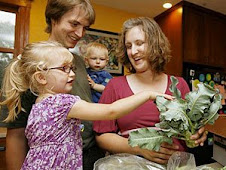In addition to the non-local items, we have been enjoying lots of local meals and ingredients: salads, deep green sauces and dressings, grilled sirloin and goat loin (Kevin did an awesome job preparing this!), and desserts of local berries and homemade goat's milk ice cream. We really have plenty to eat and lots of variety so far.
The results from our poll are in and the perishable food is gone from our pantry. Fifty-seven percent of you voted to donate the non-local food (although strangely the poll program registered 42% for keeping it... where is the extra 1% to make 100?) We gave some of the food to a friend (she wouldn't let me give it to her, she actually gave me grocery money for it!) and the remaining items will be donated.
I think this was good, as it would have persisted for quite some time if we'd tried to eat through it. This was actually a rather cleansing experience. I like having a well-stocked pantry, having staple ingredients at the ready for whatever I might like to make, but emptying those shelves and starting over felt pretty good. I think this was mostly due to the fact that I was feeling like we just weren't really getting started if we went through it all. There are still a few non-local and non-exception items on the bottom.

So, the pantry is emptier, as are the fridge and freezer, and we are continuing to look for local foods. I say the pantry is emptier and it is... and it isn't. I've been stocking up on local items for my on-hand supplies. I have no concerns about finding sufficient foodstuffs during the growing season. My greatest concern is making it through the winter and early spring months without a ready source of fresh food. So, I've been on the lookout for things I can put up myself or purchase in the approriate state.
A month ago I was elated to find Marjorie at the Edgebrook Farmers' Market with peanut butter jars full of dried beans... a great source of winter nutrients! And grown just west of here in Stephenson County! Hurray!
That first day I bought all she had. She and her booth partner were also kind enough to talk to us about dried legumes and to let Neva try her hand and shelling some. The following week I returned and when I was still a few feet away from her table Marjorie says, "It's my bean-buyer!" That's me, the bean buyer... I've bought all the beans she's had left every week. But I'm happy to be the "bean-buyer" and keep my pantry stocked for winter. I've also added a jar of beets from a friend (from last year but I've been saving them), and a jar of dill pickles from another new friend. There are a few non-local items lingering in the bottom of the pantry in this photo but we're getting there!





















